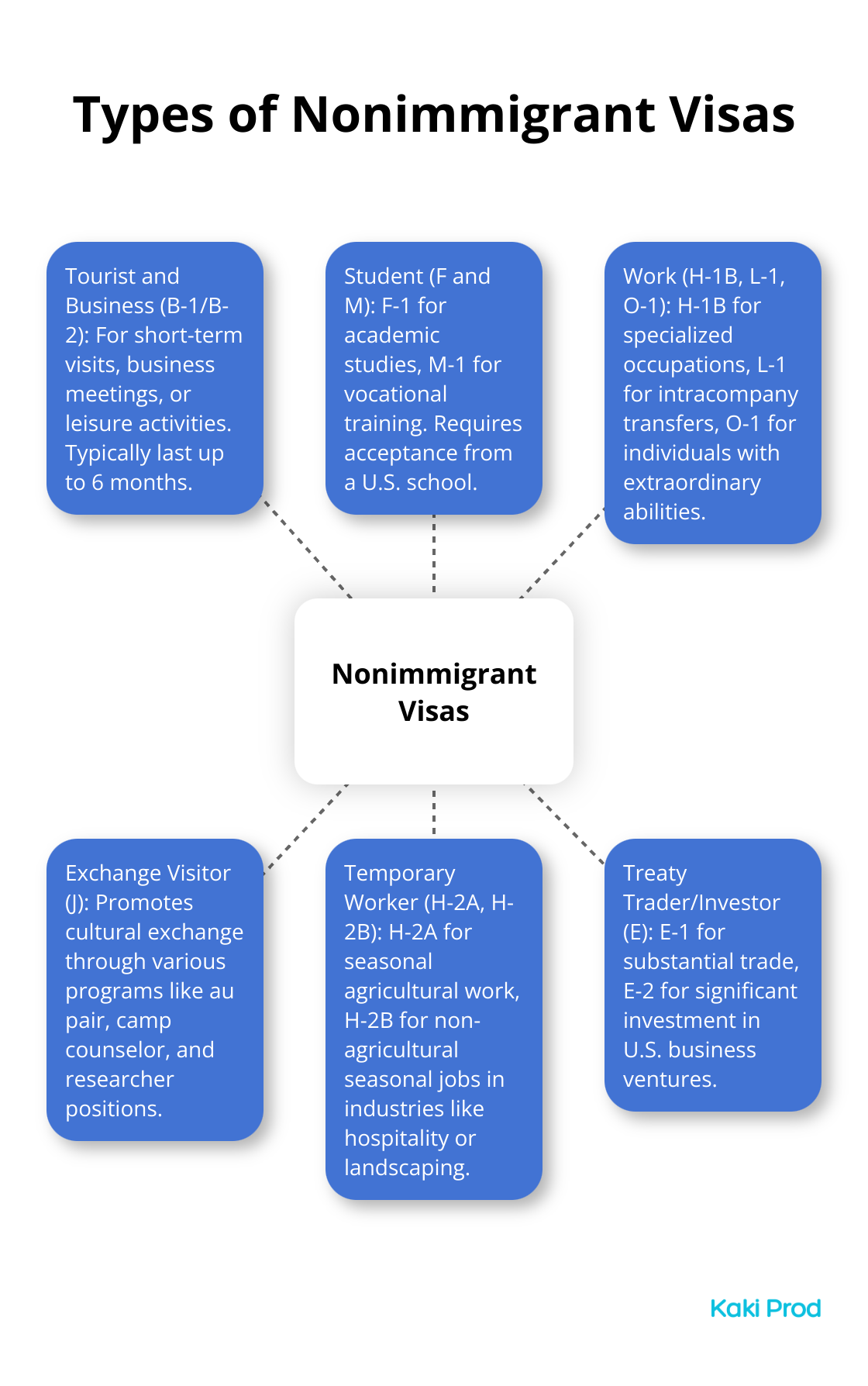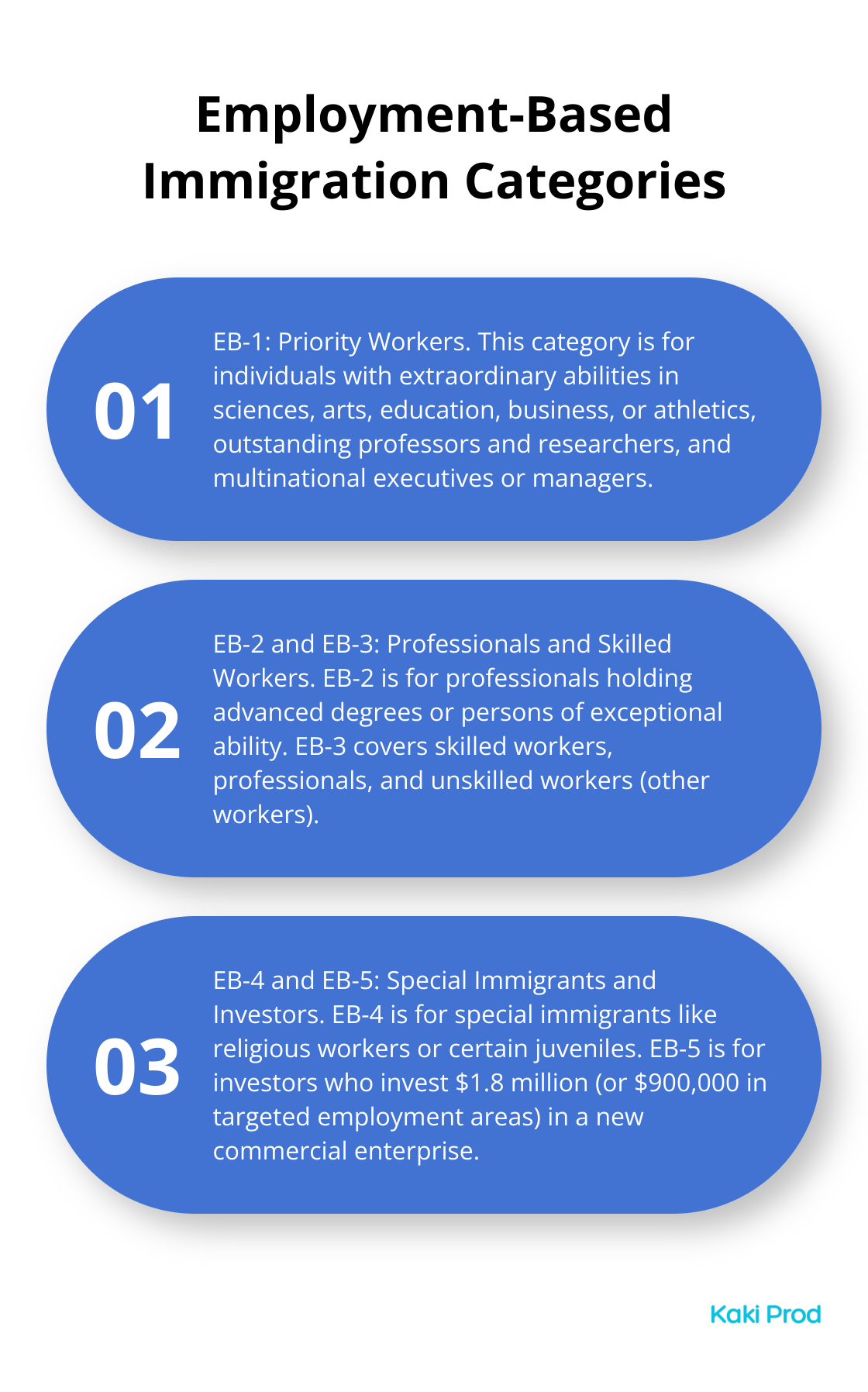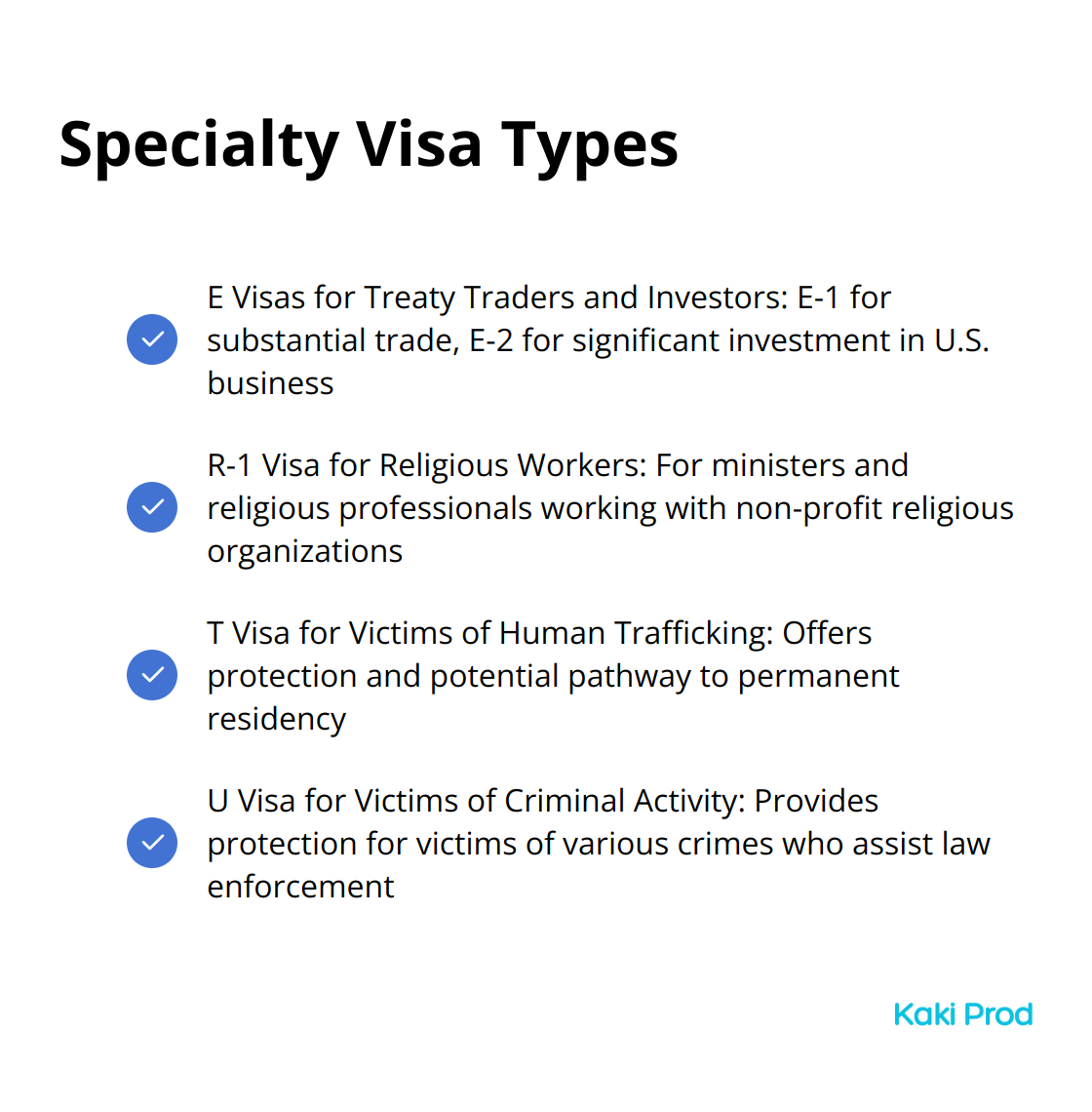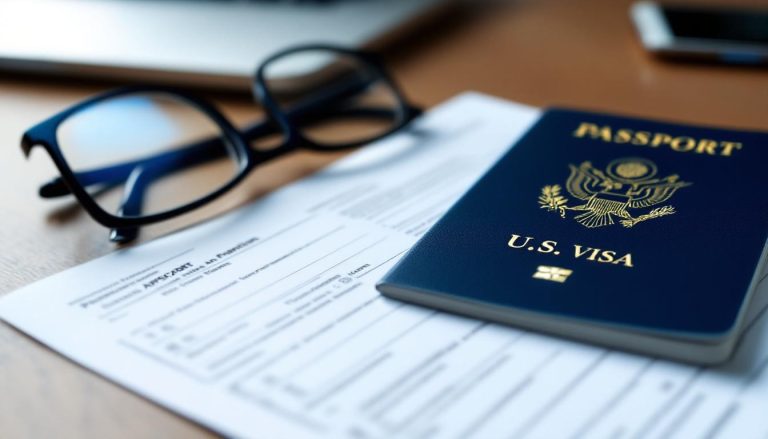Table of Contents
U.S. visas—it’s like trying to solve a Rubik’s Cube blindfolded. But at Kaki Prod, we’ve got you covered with a no-nonsense, all-you-need-to-know guide… because who has time for more confusion?
Temporary, permanent—whatever your gig, we’ve got the dirt on the whole buffet of options. You wanna study there, work, or maybe put down roots? Done. This post? It’s your cheat sheet to navigating the visa labyrinth and picking the best fit for your American dream (cue the theme music).
Nonimmigrant Visas Explained
So, nonimmigrant visas – these are your tickets for temporary gigs in the U.S. Whether you’re there to snap selfies with the Statue of Liberty, close that vital deal with your business partner, crack open the books at a U.S. school, or simply get your work-on … this is your playground. Let’s dive into the highlights:

Tourist and Business Visas (B-1/B-2)
First off, these guys cater to short adventures. B-1? That’s your passport to biz talk … think conferences or sealing that contract. B-2? Pure leisure – from snapping pics with Mickey to checking in on family or even checking in for medical fixes. Typically, these gigs last up to 6 months. The U.S. Department of State keeps the scorecard on which visas hit the scoreboard every year.
Student Visas (F and M)
F-1 visas – your backstage pass to academic enlightenment. M-1s? They roll out the red carpet for vocational skills. But here’s the catch – you’ve gotta have that acceptance letter from a U.S. school before you hit apply. The Institute of International Education is the go-to hub for the lowdown on international scholars diving into U.S. campuses.
Work Visas (H-1B, L-1, O-1)
H-1Bs … all eyes on jobs that need at least a bachelor’s degree wearing its fancy cap. Make no mistake – with 85,000 spots, the line is fierce. L-1s roll out the welcome mat for intracompany transfers, while O-1s raise the bar for individuals who shine brighter than a supernova.
Exchange Visitor Visas (J)
J-1 visas? They’re all about cultural vibes – the playground for au pairs, camp counselors, researchers … you name it.
Temporary Worker Visas (H-2A, H-2B)
H-2As? They’re the wingmen for seasonal agricultural gigs. H-2Bs? They spread the love to non-agricultural seasonal roles … picture hospitality or landscaping. These visas bridge the labor gap when industries are stretched thin. The U.S. Department of State hands out annual report cards on visa issuances.
Getting a nonimmigrant visa? Brace for proof that you’ll jet back home … showcasing your job, your real estate portfolio, or your family ties – the whole shebang.
At Kaki Prod, we’ve cracked the code – early prep is gold. Processing times? They can range anywhere from a week-long wait to a patience-testing marathon. Always – and I mean always – double-check to dodge headaches from tiny slip-ups.
Every visa out there comes with its own rulebook. Picking the right one is like matching socks – gets tricky, but you gotta nail it. If you’re scratching your head … getting professional advice might just save you a whole lot of grief.
Next up? Let’s peek into immigrant visas – these are your tickets to calling the U.S. home turf, for good.
Want to Stay in the U.S. Permanently? Your Immigrant Visa Options
Ah, the United States-the land of opportunity and, of course, a mind-boggling array of immigration pathways. Want to live here forever? Let’s dig into the main visas that put you on a permanent U.S. residency track.
Family-Based Immigration: Reuniting Loved Ones
Family is the magic word-it’s like a golden ticket in the immigration world. Here’s the lay of the land:
- If you’re an immediate relative of a U.S. citizen (think spouses, unmarried kids under 21, parents), get ready for VIP treatment with speedy processing and no annual cap drama.
- Got other fam wanting in? They’re waiting in line-a preference system means longer queues for them.
- Paperwork galore: birth certificates, marriage licenses, proof of relationship… you name it.
For the most accurate and up-to-date scoop, head over to the U.S. Department of State’s page. They’ve got the forms and fine print for all things family-based immigration.
Employment-Based Immigration: Skills in Demand
Got skills? The U.S. might just have a long-term gig for you. Employment-based immigration is where it’s at:

- Brace for five categories-from those with “extraordinary ability” (EB-1 folks doing their thing) to your friendly neighborhood unskilled workers (EB-3).
- Most gigs need a job offer and a little thing called labor certification.
- About 140,000 visas are up for grabs each year, but they run out fast-consider them a finite resource.
Keep tabs on the monthly Visa Bulletin (the U.S. Department of State publishes it) to spot which priority dates match the current flavor of the month for filing those applications.
Diversity Visa Program: A Chance for Underrepresented Nations
Enter the Diversity Visa Program-or the “green card lottery.” Because who doesn’t love a good lottery? Annually, up to 50,000 visas are for the taking if you hail from a nation with lower U.S. immigration rates. Key details:
- You need either a high school diploma or two years of work experience in a qualified field.
- Competition is fierce-you and a few million others want in.
Special Immigrant Visas: Recognizing Unique Contributions
Are you special? Like, “you-qualify-for-an-SIV” special? This is all about honoring unique contributions:
- Afghan or Iraqi nationals who had Uncle Sam’s back abroad.
- Religious workers with the right qualifications.
- Some juveniles with circumstances worthy of note.
The wait for immigrant visas varies wildly-from a breezy few months to an agonizing 20-plus years, depending on your category and where you hail from.
When you’re navigating this labyrinth of visas, think about calling in the experts. The right visa isn’t just a ticket-it’s a key to opportunities and your forever home in the U.S. Stay tuned as we dive into specialty visas that cater to unique gigs and circumstances.
Specialty Visas: Unique Pathways for Specific Situations

E Visas for Treaty Traders and Investors
E visas – here’s the thing – they’re like the golden ticket for business folks from nations with U.S. commerce bonds. The E-1? It’s for those wheeling and dealing in hefty trade volumes. Meanwhile, the E-2 visa is all about dropping major dough into a U.S. business venture.
But, don’t get too comfy just yet – qualifying for an E-2 visa means you gotta hail from a treaty country and throw down a decent wad of cash into the biz stateside. The check size? Well, it dances around depending on what business gig you’re tackling.
R-1 Visa for Religious Workers
And then there’s the R-1 visa – the front door for ministers and religious trailblazers heading to work with non-profit religious outfits in the U.S. Wanna jump on this wagon? Two years of membership in your spiritual squad is the ticket, plus a solid 20-hour work week.
Heads up: Five years max. That’s your clock. Afterward? Pack your bags for a year back home before resetting and reapplying. Oh, and don’t forget – you’ll need to show they’re paying you, like with budget sheets earmarking funds for your paycheck.
T and U Visas for Victims of Crime
T and U visas, critical lifelines for those who’ve faced the nastiest of crimes. The T visa? Strictly for the human trafficking casualties. U visa, though? Think broader – victims of a slew of criminal events.
To snag a T visa, show proof you got trafficked here and are on board to help nail the traffickers. U visa seekers need to prove they’ve suffered real physical or mental harm and are making nice with law enforcement officers.
These visas don’t just promise protection but a possible welcome mat to permanent residency. Snap this: a USCIS report reveals around 14% of U visa hopefuls were labeled as “overstay” visa statuses, while 4.7% were in legit stances back during the incident.
Navigating Specialty Visas
Each type of specialty visa serves up its own hoops and hurdles. Tangled complexity often calls for a seasoned navigator – someone savvy enough to steer which visa path best complements your scenario. It’s crucial to lock in the right visa for a seamless slide into U.S. adventures.
Quick Comparison: Nonimmigrant vs Immigrant Visas
| Visa Type | Category | Purpose | Eligibility | Duration | Work Allowed? |
|---|---|---|---|---|---|
| B1/B2 | Nonimmigrant | Business or Tourism | All nationalities, based on travel intent | Up to 6 months | ❌ Not permitted |
| F1 | Nonimmigrant | Study in the U.S. | Accepted by a U.S. school (I-20 required) | Length of study + 60 days | ✅ Limited (on-campus, CPT/OPT) |
| J1 | Nonimmigrant | Exchange Programs (Au pair, scholar, etc.) | Sponsored by U.S. exchange program | Varies by program | ✅ Often allowed |
| H-1B | Nonimmigrant | Specialized Skilled Workers | U.S. employer sponsorship + degree | Up to 6 years | ✅ Yes |
| L-1 | Nonimmigrant | Intra-company Transfer | Employed abroad at least 1 year | 1–7 years | ✅ Yes |
| O1 | Nonimmigrant | Individuals with Extraordinary Ability | National/international recognition required | Varies (renewable) | ✅ Yes |
| EB-2 / EB-3 | Immigrant (Green Card) | Employment-Based Immigration | Employer sponsorship + PERM process | Permanent | ✅ Yes |
| IR-1 / CR-1 | Immigrant (Green Card) | Spouse of U.S. Citizen | Marriage to a U.S. citizen | Permanent (with conditions for CR-1) | ✅ Yes |
| DV Lottery | Immigrant | Diversity Visa Lottery | Selected via annual lottery + eligibility rules | Permanent |
✅ Yes
|
For a comprehensive overview of U.S. visa categories, refer to the U.S. Department of State’s Visa Categories Directory.
Final Thoughts
Let’s talk U.S. visas-because, oh boy, there’s a smorgasbord of them. Each has its own style, purpose, and flavor. We’re talking everything from a quick in-and-out trip to staking your claim as a permanent resident. Now here’s the kicker: picking the right one is the golden ticket to avoiding bureaucratic nightmares. Choose wrong, and-boom-you’re knee-deep in delays, denials, and legal minefields.
So, where do you turn for the gospel of visa wisdom? Enter the U.S. Department of State and U.S. Citizenship and Immigration Services. Their websites? A treasure trove of info on visa types, the lowdown on application steps, and, yep, the dreaded processing times. Don’t forget the local U.S. embassies and consulates-they’ve got the deets specific to your neck of the woods. All these resources are your own Excalibur-for hacking through the immigration jungle.
Now, at Kaki Prod, we get it. Visa navigation is akin to decoding hieroglyphics. That’s why we’re here to arm you with the knowledge on this Odyssey. Our platform at EverydayNext is packed with resources to help you chase your American dream-be it climbing the career ladder, launching that startup, or just taking personal growth to the next level (all in a day’s work).
Frequently Asked Questions (FAQs)
1. What are the main types of U.S. visas?
There are two main categories of U.S. visas: nonimmigrant visas for temporary stays (like tourism, study, or work) and immigrant visas for people moving permanently to the U.S.
2. What is the difference between a B1 and B2 visa?
The B1 visa is for short-term business trips, while the B2 visa is for tourism, visiting family, or medical care. Most travelers receive a combined B1/B2 visa.
3. Can I work in the U.S. with a tourist visa?
No. Tourist visas (like B2) do not allow you to work in the U.S. If you want to work, you need a visa like H-1B, O1, or L-1.
4. What is the H-1B visa used for?
The H-1B visa is for skilled professionals working in specialty occupations such as IT, engineering, or healthcare. You need a job offer from a U.S. employer to apply.
5. Which visa do I need to study in the U.S.?
You need an F1 student visa. You must first be accepted by a U.S. school, which gives you a document called an I-20 to apply.
6. What is an immigrant visa?
An immigrant visa is for people who plan to move permanently to the U.S. Examples include green card categories for family, employment, or the Diversity Visa (DV) lottery.
7. Can I bring my family on a work visa?
Yes. Many work visas (like H-1B or L-1) allow spouses and children to apply for dependent visas such as H-4 or L-2.
8. What is the Diversity Visa Lottery?
Also known as the Green Card Lottery, the DV Program randomly selects people from eligible countries to apply for a U.S. immigrant visa.
9. How long can I stay in the U.S. with a visa?
It depends on the visa type. Tourist visas are usually valid for 6 months, while work or student visas may last for years with possible extensions.
10. Can I change my visa type while in the U.S.?
Sometimes, yes. You can apply to change status (e.g., from student to worker), but you must meet eligibility rules and apply before your current visa expires.
Have a question about your visa type? Leave a comment below and we’ll do our best to help or guide you to the right source.

